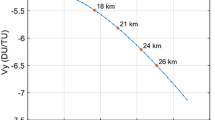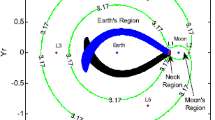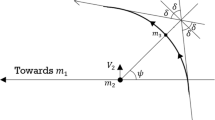Abstract
We construct a new type of transfer from the Earth to Mars, which ends in ballistic capture. This results in substantial savings in capture \(\varDelta v\) from that of a classical Hohmann transfer under certain assumptions as well as an alternate way for spacecraft to transfer to Mars. This is accomplished by first becoming captured at Mars, very distant from the planet, and then from there, following a ballistic capture transfer to a desired altitude within a ballistic capture set. This is achieved by using stable sets, which are sets of initial conditions whose orbits satisfy a definition of orbital stability. This transfer type may be of interest for Mars missions because of low capture \(\varDelta v\), flexibility of launch period from the Earth, moderate flight time, and the benign nature of the capture process.









Similar content being viewed by others
References
Belbruno, E.: Capture Dynamics and Chaotic Motions in Celestial Mechanics: With Applications to the Construction of Low Energy Transfers. Princeton University Press, Princeton (2004)
Belbruno, E., Miller, J.: Sun-perturbed Earth-to-Moon transfers with ballistic capture. J. Guid. Control Dyn. 16, 770–775 (1993)
Belbruno, E., Gidea, M., Topputo, F.: Weak stability boundary and invariant manifolds. SIAM J. Appl. Dyn. Syst. 9(3), 1061–1089 (2010). doi:10.1137/090780638
Belbruno, E., Gidea, M., Topputo, F.: Geometry of weak stability boundaries. Qual. Theory Dyn. Syst. 12(1), 53–66 (2013). doi:10.1007/s12346-012-0069-x
Belbruno, E., Topputo, F., Gidea, M.: Resonance transition associated to weak capture in the restricted three-body problem. Adv. Space Res. 42(8), 18–39 (2008). doi:10.1016/j.asr.2008.01.018
Castillo, A., Belló-Mora, M., Gonzalez, J.A., Janint, G., Graziani, F., Teofilatto, P., Circi, C.: Use of weak stability boundary trajectories for planetary capture. In: Paper IAF-03-A.P.31, Proceedings of the International Astronautical Conference (2003)
Chung, M.J., Hatch, S.J., Kangas, J.A., Long, S.M., Roncoli, R.B., Sweetser, T.H.: Trans-lunar cruise trajectory design of GRAIL (Gravity Recovery and Interior Laboratory) Mission. In: Paper AIAA 2010–8384, AIAA Guidance, Navigation, and Control Conference, Toronto, Ontario, Canada, 2–5 Aug (2010)
García, F., Gómez, G.: A note on weak stability boundaries. Celest. Mech. Dyn. Astron. 97, 87–100 (2007). doi:10.1007/s10569-006-9053-6
Hyeraci, N., Topputo, F.: Method to design ballistic capture in the elliptic restricted three-body problem. J. Guid. Control Dyn. 33(6), 1814–1823 (2010). doi:10.2514/1.49263
Hyeraci, N., Topputo, F.: The role of true anomaly in ballistic capture. Celest. Mech. Dyn. Astron. 116(2), 175–193 (2013). doi:10.1007/s10569-013-9481-z
Lo, M.W., Ross, S.D.: Low energy interplanetary transfers using the invarian manifolds of \(L_1\), \(L_2\), and halo orbits. In: Paper AAS 98–136, Proceedings of the AAS/AIAA Space Flight Mechanics Meeting (1998)
Luo, Z.F., Topputo, F., Bernelli-Zazzera, F., Tang, G.J.: Constructing ballistic capture orbits in the real solar system model. Celest. Mech. Dyn. Astron. 120(4), 433–452 (2014). doi:10.1007/s10569-014-9580-5
Makó, Z.: Connection between hill stability and weak stability in the elliptic restricted three-body problem. Celest. Mech. Dyn. Astron. 120(3), 233–248 (2014). doi:10.1007/s10569-014-9577-0
Makó, Z., Szenkovits, F., Salamon, J., Oláh-Gál, R.: Stable and unstable orbits around Mercury. Celest. Mech. Dyn. Astron. 108(4), 357–370 (2010). doi:10.1007/s10569-010-9309-z
Mingotti, G., Topputo, F., Bernelli-Zazzera, F.: Earth–Mars transfers with ballistic escape and low-thrust capture. Celest. Mech. Dyn. Astron. 110(2), 169–188 (2011). doi:10.1007/s10569-011-9343-5
Romagnoli, D., Circi, C.: Earth–Moon weak stability boundaries in the restricted three and four body problem. Celest. Mech. Dyn. Astron. 103(1), 79–103 (2009). doi:10.1007/s10569-008-9169-y
Schoenmaekers, J., Horas, D., Pulido, J.A.: SMART-1: with solar electric propulsion to the Moon. In: Proceeding of the 16th International Symposium on Space Flight Dynamics (2001)
Sousa Silva, P., Terra, M.: Applicability and dynamical characterization of the associated sets of the algorithmic weak stability boundary in the lunar sphere of influence. Celest. Mech. Dyn. Astron. 113(2), 141–168 (2012a). doi:10.1007/s10569-012-9409-z
Sousa Silva, P., Terra, M.: Diversity and validity of stable–unstable transitions in the algorithmic weak stability boundary. Celest. Mech. Dyn. Astron. 113(4), 453–478 (2012b). doi:10.1007/s10569-012-9418-y
Szebehely, V.: Theory of Orbits: The Restricted Problem of Three Bodies. Academic Press Inc, London (1967)
Topputo, F.: On optimal two-impulse Earth–Moon transfers in a four-body model. Celest. Mech. Dyn. Astron. 117(3), 279–313 (2013). doi:10.1007/s10569-013-9513-8
Topputo, F., Belbruno, E.: Computation of weak stability boundaries: Sun–Jupiter system. Celest. Mech. Dyn. Astron. 105(1–3), 3–17 (2009). doi:10.1007/s10569-009-9222-5
Topputo, F., Belbruno, E., Gidea, M.: Resonant motion, ballistic escape, and their applications in astrodynamics. Adv. Space Res. 42(8), 6–17 (2008). doi:10.1016/j.asr.2008.01.017
Topputo, F., Vasile, M., Bernelli-Zazzera, F.: Low energy interplanetary transfers exploiting invariant manifolds of the restricted three-body problem. J. Astron. Sci. 53(4), 353–372 (2005)
Acknowledgments
We would like to thank the Boeing Space Exploration Division for sponsoring this work, and, in particular, we would like to thank Kevin Post and Michael Raftery. We would also like to thank Cesar Ocampo of NASA JSC for helpful comments.
Author information
Authors and Affiliations
Corresponding author
Appendices
Appendix 1: Summary of precise definitions of stable sets and weak stability boundary
Trajectories of \(P\) satisfying the following conditions are studied (see García and Gómez 2007; Topputo and Belbruno 2009; Hyeraci and Topputo 2010).
-
(i)
The initial position of \(P\) is on a radial segment \(l(\theta )\) departing from \(P_2\) and making an angle \(\theta \) with the \(P_1\)–\(P_2\) line, relative to the rotating system. The trajectory is assumed to start at the periapsis of an osculating ellipse around \(P_2\), whose semi-major axis lies on \(l(\theta )\) and whose eccentricity \(e\) is held fixed along \(l(\theta )\).
-
(ii)
In the \(P_2\)-centered inertial frame, the initial velocity of the trajectory is perpendicular to \(l(\theta )\), and the Kepler energy, \(H_2\), of \(P\) relative to \(P_2\) is negative; i.e., \(H_2<0\) (ellipse periapsis condition). The motion, for fixed values of \(e\), \(f_0\), \(\theta \) depends on the initial distance \(r\) only.
-
(iii)
The motion is said to be \(n\)-stable if the infinitesimal mass \(P\) leaves \(l(\theta )\), makes \(n\) complete revolutions about \(P_2\), \(n \ge 1\), and returns to \(l(\theta )\) on a point with negative Kepler energy with respect to \(P_2\), without making a complete revolution around \(P_1\) along this trajectory. The motion is otherwise said to be \(n\)-unstable (see Fig. 10).
The set of \(n\)-stable points on \(l(\theta )\) is a countable union of open intervals
with \(r_1^*=0\). The points of type \(r^*\) (the endpoints of the intervals above, except for \(r^*_1\)) are \(n\)-unstable. Thus, for fixed pairs \((e, f_0)\), the collection of \(n\)-stable points is
The weak stability boundary of order \(n\), \(\partial {\mathcal {W}}_n\), is the locus of all points \(r^*(\theta , e, f_0)\) along the radial segment \(l(\theta )\) for which there is a change of stability of the trajectory; i.e., \(r^*(\theta , e, f_0)\) is one of the endpoints of an interval \((r^*_{2k-1}, r^*_{2k})\) characterized by the fact that, for all \(r \in (r^*_{2k-1}, r^*_{2k})\), the motion is \(n\)-stable, and there exist \(\tilde{r} \not \in (r^*_{2k-1}, r^*_{2k})\), arbitrarily close to either \(r^*_{2k-1}\) or \(r^*_{2k}\) for which the motion is \(n\)-unstable. Thus,
Appendix 2: Computation of reference Hohmann transfers
The physical constants used in this work are listed in Table 4. As both the Earth and Mars are assumed as moving on elliptical orbits, there are four cases in which a bitangential transfer is possible, depending on their relative geometry. These are reported in Table 5, where ‘@P’ and ‘@A’ mean ‘at perihelium’ and ‘at aphelium’, respectively. In Table 5, \(\varDelta V_1\) is the maneuver needed to leave the Earth orbit, whereas \(\varDelta V_{2, \infty }\) is the maneuver needed to acquire the orbit of Mars; these two impulses are calculated by considering the spacecraft already in heliocentric orbit, and therefore \(\varDelta V_1\), \(\varDelta V_{2,\infty }\) are equivalent to the escape, incoming hyperbolic velocities, respectively. \(\varDelta V\) and \(\varDelta t\) are the total cost and flight time, respectively. The use of the notation, \(\varDelta V_{2,\infty }\) is to distinguish from the use of \(\varDelta V_2\) used in Sect. 6 for the actual maneuver cost at \(r_p\).
From the figures in Table 5 it can be inferred that although the total cost presents minor variations among the four cases, the costs for the two maneuvers change considerably. That is, by arbitrary picking one of the four bitangential solutions as reference we can have different outcomes on the performance of the ballistic capture orbits devised. Because there is a substantial variation, an averaging does not yield useful results, and therefore, each case is considered.
Rights and permissions
About this article
Cite this article
Topputo, F., Belbruno, E. Earth–Mars transfers with ballistic capture. Celest Mech Dyn Astr 121, 329–346 (2015). https://doi.org/10.1007/s10569-015-9605-8
Received:
Revised:
Accepted:
Published:
Issue Date:
DOI: https://doi.org/10.1007/s10569-015-9605-8





